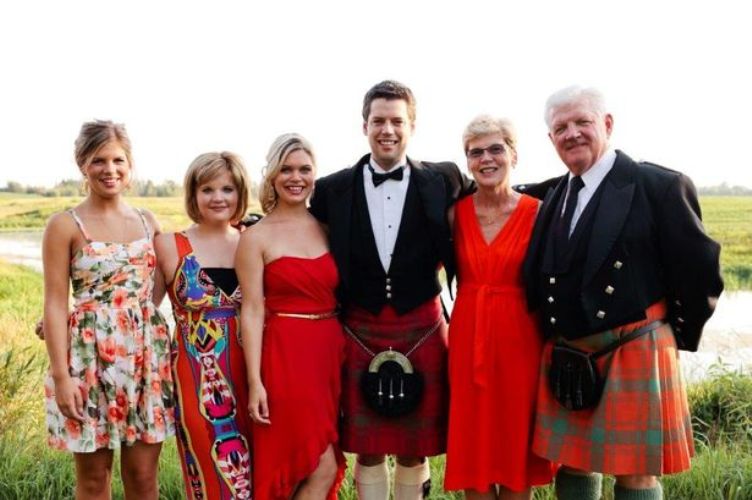
Celtic Life International celebrates three decades of preserving and promoting a living, breathing culture.
It started in Halifax, Nova Scotia, quickly branching out across four Atlantic Canadian provinces. Within a short while, it wove its way through Quebec and Ontario, en route to Alberta and British Columbia. Then, like all good Canadian snowbirds, it trekked south along the eastern seaboard through Maryland, the Virginias, the Carolinas and Florida, before heading west to Texas and California, north to the state of Washington, and back east via Illinois, Indiana, Michigan, Ohio, Pennsylvania, New York and Massachusetts.
In recent years, it has made its way to more exotic locals, including Australia, New Zealand, Cuba, Brazil, Hong Kong, Indonesia, Israel and South Africa.
And, of course, it has found its way home to the motherlands of Scotland, Ireland, Wales, Cornwall, the Isle of Man, Brittany and Galicia.
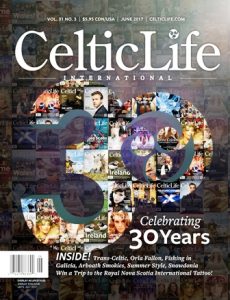 Today, it connects the Celtic dots all around the world, reconnecting people with their history and heritage, and creating a vision for the future of a global community.
Today, it connects the Celtic dots all around the world, reconnecting people with their history and heritage, and creating a vision for the future of a global community.
As Celtic Life International celebrates its 30th anniversary, founder and publisher Angus M. (Marcie) Macquarrie reflects on his publication’s rich and rewarding journey.
“Interest in Celtic culture has always been what has driven us to do what we do,” he says. “It is an innate curiousity about what we share, and who we share it with.
“As with others before us, we are merely doing our part to preserve it and pass it down to future generations.”
Like the Macquarrie family themselves, the magazine found its footing with honest, hardworking and humble roots.
Celtic Life International first published in 1987 as a simple newsletter – a small vehicle of communication for Nova Scotia’s International Gathering of the Clans.
“I had some experience publishing a weekly community newspaper (Scotia Sun of Port Hawkesbury, NS),” explains Macquarrie, “and I was invited to generate some extra publicity for the event. The newsletter we put out at that time proved so popular that when the gathering was over the interest remained and we were encouraged to continue doing it.”
He recalls St. FX (university, Antigonish, NS) sociology professor Dan MacInnes insisting that the newsletter, and Celtic culture, belonged on a bigger stage, perhaps even serving an international market.
“I was piqued by what he said, but I knew all too well the costly limitations of print and distribution. His words, impossible though they seemed at the time, stayed with me.”
With a small team of support, and limited funding, Macquarrie nonetheless committed to putting out a quarterly publication. And though he no longer recollects who bought the first subscription, “I remember it was $20 cash that somebody handed to me in a restaurant.”

The seeds of Celtic Life International were sown years earlier during Macquarrie’s boyhood in northern Nova Scotia, where hardwood stands give way to farm fields that roll down to the sea. The Arisaig area was settled by families from the western highlands and islands of Scotland between 1791 and the early 1800s. Most of these Highlanders had family on the losing side at the historic Battle of Culloden.
“The Macquarries came from the Isle of Eigg, and the Gillis clan – on my mother’s side – arrived from Morar. My bloodline also contains MacLeods, MacLeans, Chisholms, MacDonnells, MacDonalds and Robertsons.”
Born into a Gaelic-speaking household where traditions were held high, he savoured the stories recounted by older generations, and took piping lessons as a youngster.
“My Macquarrie grandfather, who was born in 1862, travelled to Scotland for a year in 1889. From his correspondences, it was evident that he proudly considered himself a supporter of the Jacobite cause. From an early age I was exposed to storytelling, piping, fiddle music and step dancing.
“I am defined by the blood that runs through my veins.”
That heritage, notes Celtic Life International’s Managing Editor Stephen Patrick Clare, makes Macquarrie a natural seanchai.
“Story-telling and Celtic culture are synonymous with one another and Marcie is fascinated with stories of human beings, especially those of Celtic heritage.”
Macquarrie and his partner in Celtic Life and family life, Cabrini MacIsaac Macquarrie, were raised within 20 minutes of each other. She shares his west coast Scottish roots on her father’s side, though her mother was Newfoundland Irish.
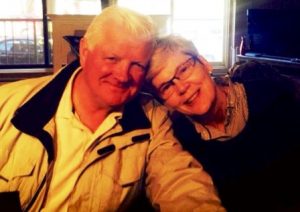
“We met at a dance at the 4 Valleys Fire Hall, not far from where we each grew up,” she remembers with a smile. “We both liked the old-time music, and there was a band playing there that night.”
“Cabrini is my beautiful bride,” beams Marcie. “And her involvement with the magazine has been essential from the get-go. It would not have survived without her input, skills, and endless support.”
Before long, as part of a Nova Scotia tourism delegation, Macquarrie carried copies of his fledgling magazine – now called The Clansman – on a trade mission to Baltimore.
“I think it was somebody in the department of tourism who’d actually named it The Clansman, and we quickly realized that the title of the publication wasn’t going to go over well in the deep American south, so we changed it to Celtic Heritage – a more fitting name, as the content had evolved to a more inclusive cultural publication.
“In the beginning, I was thinking only in terms of Scottish heritage. But slowly, over time, we began to wake up to the rest of the Celtic world.”
The refocus expanded the publication’s audience from Nova Scotia and Atlantic Canada, to eastern Ontario and the eastern United States.
Alison Macquarrie, one of the Macquarries’ four grown children, came of age with the magazine, watching it evolve from a small publication to a global voice.
“Both my parents have worked extremely hard to grow the business and they never gave up,” she says. “They always found interesting topics, new music and books to review, fresh ways to write innovative features…and of course, Mom’s cookbook (Cabrini’s Celtic Kitchen) has been fun for all of us.”
The publication’s evolution was reached via a series of well-timed, well-placed plateaus.
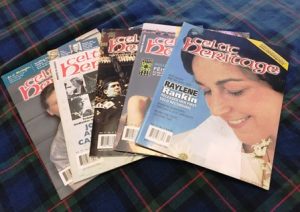
“Early on, the technology was a nightmare,” recalls Macquarrie, “although at the time we didn’t realize it. Our circulation numbers were low, and it was costly to promote to new subscribers. As a result it took a lot longer to reach new people.”
Within just a few short years, however, advances in technology made it simpler, and more affordable, to reach a wider audience.
“With increasing computer capacity, we were able to develop a data base of subscribers much more efficiently. At that point we could reach more people at less cost, and new methods of production and printing made publishing easier.”
By the mid-1990s, the magazine had rebranded as “Celtic Life” under then-editor Alexa Thompson, emphasizing lifestyle and Celtic culture as a “living, breathing” entity.
“Alexa did an good job keeping us relevant for a long time,” continues Macquarrie. “Her focus on contemporary Celtic culture helped us to define, and to some degree refine, what it means to be Celtic today.”
Clare says that was a turning point for the publication.
“Alexa recognized that there were people of Celtic heritage all over the world. She jumped on board the globalization train, and our numbers grew quite quickly.”
By the time Clare took the reins in 2012, immediately renaming the magazine Celtic Life International to better reflect its ever-expanding readership, the publication was ready to reach even further heights.

“I had worked in print journalism for a long time,” shares the native Montrealer, who is of Irish heritage. “And while I saw, first-hand, the toll that the internet was taking on newspapers and magazines, I also saw the tremendous online opportunities for Celtic Life.”
“Stephen is a very smart, experienced and ethical journalist,” says Macquarrie. “He is incredibly tech savvy and capable, and he understands the power of digital platforms to grow our reach to an almost limitless audience.”
Today, between the bi-monthly print and digital editions, a recently-revamped website, and strong social media channels, Celtic Life International reaches almost 2.5 million readers in 71 countries, making it the largest community of its kind in the world.
“We have also partnered with the biggest Celtic-themed events in the world,” continues Clare, “including the Royal Nova Scotia International Tattoo, NYC Tartan Week, Festival Interceltique de Lorient, Celtic Colours International Festival, The Pipes of Christmas, and countless Highland Games.”
While he acknowledges the magazine’s dramatic rise, Clare is quick to reiterate that it remains a family-run endeavor.
“It started as a grassroots family publication and, despite the massive growth, has maintained those family roots and values.”
“I mean, this is literally an actual family; a mom and dad and four kids, who – together with a few employees – have reached out to all four corners of the planet.”

For the Macquarries, those Celtic customs are shared in blood as well as ink; music has been an ever-present soundtrack in the family home; son Hector has won local and international piping competitions, and Alison, along with her younger sibling Sheena, plays the piano, as does the youngest daughter, Meaghan, who has recently taken up the fiddle.
In addition, Alison was a highland dancer.
“I danced for years, beginning as a small child and continuing into my twenties – Highland dance, step dance and Irish dance. Mom and Dad always encouraged my development, and never hesitated to take me to competitions and summer camps at the Gaelic College to further my abilities.
“Both my parents are proud of their heritage, family, and Celtic culture,” she continues “They taught us the importance of knowing who we are, and where we come from. The ability to connect with our past has been important to them, and it is a beautiful value they taught all of their children.”
By turns, as Marcie and Cabrini have passed along Celtic customs to their own children, Celtic Life International is an extension of their commitment to the global Celtic family.
“The passion Marcie has for it has kept it going when others, God knows there must have been many, couldn’t make a go of things,” says Halifax businessman Denis Ryan, who grew up in Tipperary, Ireland. “He’s always had a fierce determination to find a way, to get it done. Look at it today, every issue getting better and better, always informative, and the presentation is first class.”
Dr. Breesha Maddrell, director of Culture Vanin on the Isle of Man, suggests the bi-monthly is a “bright and modern way” of connecting Celts from around the world.
“Being one of the smaller Celtic countries, we – maybe more than anyone, perhaps – know the importance of sharing ideas, of belonging to a continuum – a seamless cloth – whether for the language, music and dance or culture, generally.”
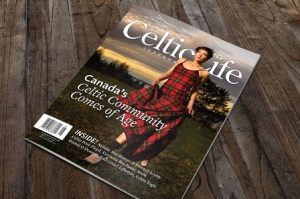
Alan Bain, president of the American Scottish Foundation, has been instrumental in establishing Tartan Week in NYC and co-chairs the annual Scottish North American Leadership Conference.
“I always find the magazine of great interest, and it is through sharing information that we strengthen our various organizations. Teaming up with other Celtic peoples creates an additional opportunities for all of us.”
Bob Currie, president of the Clan Currie worldwide and founder of both The Pipes of Christmas and Tartan Day on Ellis Island, looks to the publication for inspiration
“I’ve been with Celtic Life International since it was Celtic Heritage, printed on dingy newsprint. I love its new energy and social media presence. It has been a great teacher in how to use social media to promote the culture. Keeping in touch can be as simple as a poignant photo or a bagpipe joke.”
Tartan Day founder Jean MacKaracher Watson of Halifax, NS, a warrior for Celtic culture, says that Celtic Life International’s evolution has been nothing short of triumphant.
“There were years when promoting our culture took very hard work, so it is encouraging to see how far we have come. I still love the local stories, but isn’t it a wonderful thing that a little magazine from Nova Scotia has become so well known and read in places like Toronto, the U.S., and in Scotland, itself?”
Catherine McArthur, whose Scottish family history moves back and forth across the Quebec-Ontario border, put her daughters into highland dancing at a young age. Today she has a daughter who plays the pipes, a grandson who pipes, and another grandson who is a fiddler. She also purchases five subscriptions each year to Celtic Life International.
“I received it first as a gift, and after reading a few editions I started giving it as a gift. I read most everything, but I certainly enjoy the recipes.”

Many transplanted Celts, including history buff Andy Thomson of Antigonish, NS – who recently had his DNA analyzed to see if there was anything he did not yet know about his Scottish heritage – turn to the magazine to stay in touch with their roots.
“I grew up in Glasgow and came to Canada in 1965. Growing up, I think we Scots felt a connection to our homelands, as many of us had a grandparent or two come from there, but we didn’t have any sense of Celts around the world. I find it quite amazing to read stories of Celts in such far-flung places.”
Long-time reader, Ron “D.D.” McDonald – also of Antigonish – sees Celtic Life International as a window to the world.
“You almost believe that you can make your way to Ireland right through the pages themselves,” he says, referring to a recent cover story. “Every issue is a journey to places I may not have been, or may not even have thought to go.”
Clare loves the analogy.
“I like to think that we take you somewhere with each issue…and not necessarily with any particular destination in mind.”
“If anything, the journey is the destination – with a beginning, middle, and an end…similar, perhaps, to a fine meal with an entrée, a main course, and a delicious dessert. When done, we want our readers to feel fulfilled, and that their lives have been enriched.”
To that end, he says, it is all about the quality of content.
“In our “surf and scan” world of macro and micro media, the Celtic life International experience – both in print and online – has to be entertaining, educational, and, perhaps most of all, engaging.
 “Preserving and promoting cultural identity, especially to the younger generations, is a huge responsibility,” he adds. “It’s not enough for us to be successful; we must continue to be significant to our readers and to our community.”
“Preserving and promoting cultural identity, especially to the younger generations, is a huge responsibility,” he adds. “It’s not enough for us to be successful; we must continue to be significant to our readers and to our community.”
Macquarrie agrees.
“As it has been since we put out that little newsletter 30 years ago, and as it remains to this very day, our readers are the most important part of Celtic Life International. They are the reason that we do what we do, and they are why we are looking forward to doing it for another 30 years.”
Watch the short documentary film here!




















Leave a Comment